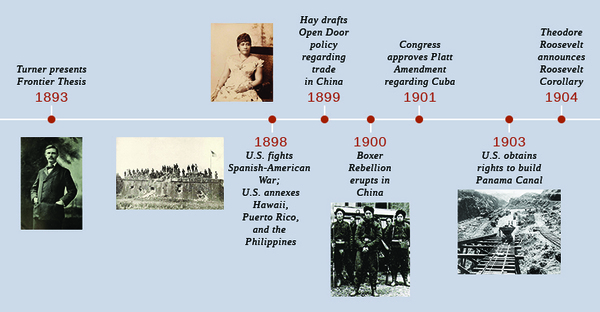| << Chapter < Page | Chapter >> Page > |

During the time of Reconstruction, the U.S. government showed no significant initiative in foreign affairs. Western expansion and the goal of Manifest Destiny still held the country’s attention, and American missionaries proselytized as far abroad as China, India, the Korean Peninsula, and Africa, but reconstruction efforts took up most of the nation’s resources. As the century came to a close, however, a variety of factors, from the closing of the American frontier to the country’s increased industrial production, led the United States to look beyond its borders. Countries in Europe were building their empires through global power and trade, and the United States did not want to be left behind.
On the eve of the Civil War, the country lacked the means to establish a strong position in international diplomacy. As of 1865, the U.S. State Department had barely sixty employees and no ambassadors representing American interests abroad. Instead, only two dozen American foreign ministers were located in key countries, and those often gained their positions not through diplomatic skills or expertise in foreign affairs but through bribes. Further limiting American potential for foreign impact was the fact that a strong international presence required a strong military—specifically a navy—which the United States, after the Civil War, was in no position to maintain. Additionally, as late as 1890, with the U.S. Navy significantly reduced in size, a majority of vessels were classified as “Old Navy,” meaning a mixture of iron hulled and wholly wooden ships. While the navy had introduced the first all-steel, triple-hulled steam engine vessels seven years earlier, they had only thirteen of them in operation by 1890.
Despite such widespread isolationist impulses and the sheer inability to maintain a strong international position, the United States moved ahead sporadically with a modest foreign policy agenda in the three decades following the Civil War. Secretary of State William Seward, who held that position from 1861 through 1869, sought to extend American political and commercial influence in both Asia and Latin America. He pursued these goals through a variety of actions. A treaty with Nicaragua set the early course for the future construction of a canal across Central America. He also pushed through the annexation of the Midway Islands in the Pacific Ocean, which subsequently opened a more stable route to Asian markets. In frequent conversations with President Lincoln, among others, Seward openly spoke of his desire to obtain British Columbia, the Hawaiian Islands, portions of the Dominican Republic, Cuba, and other territories. He explained his motives to a Boston audience in 1867, when he professed his intention to give the United States “control of the world.”

Notification Switch
Would you like to follow the 'U.s. history' conversation and receive update notifications?